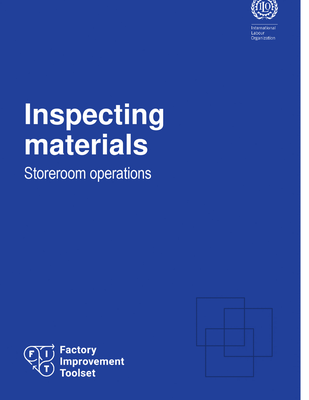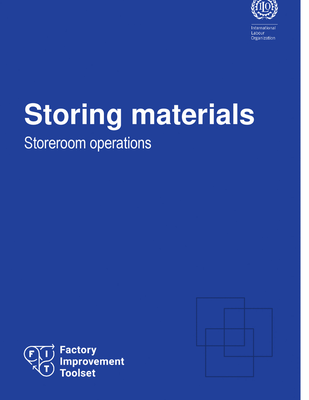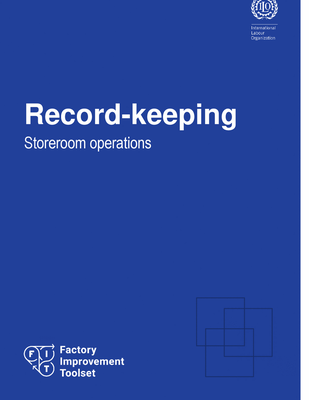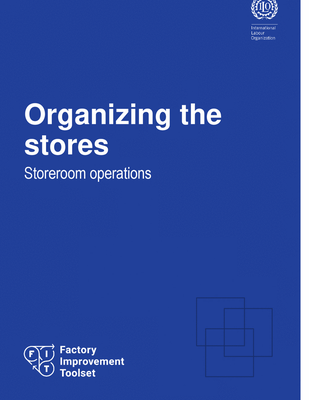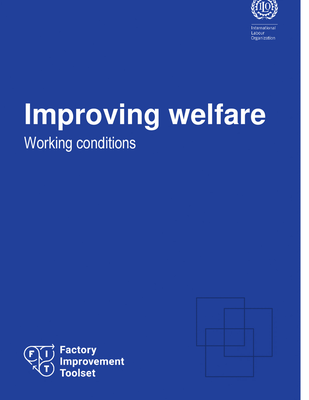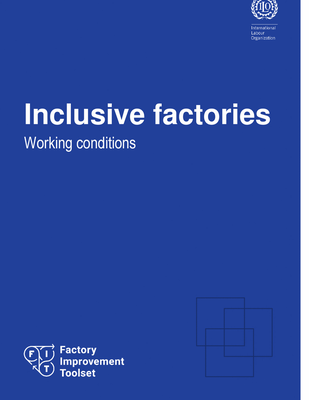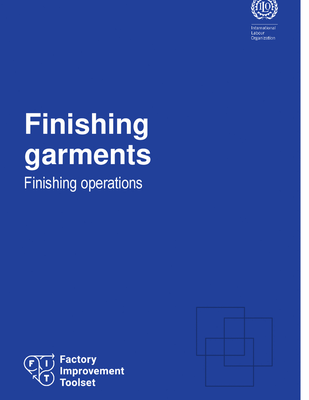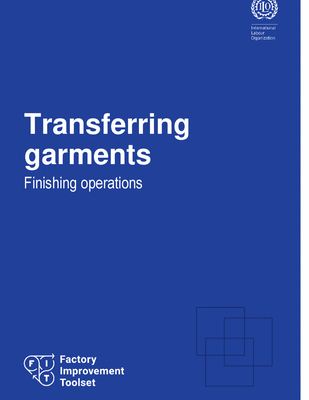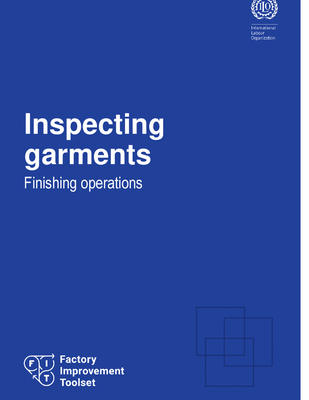Factory Improvement Toolset: Inspecting materials - Storeroom operations
'Inspecting materials' is a training for garment manufacturers to improve storeroom operations. Participants will work on inspecting materials in a more detailed, systematic way.
View
|
Full View
|
Download
 Arron Goldman
|
August 08, 2021
Arron Goldman
|
August 08, 2021
Factory Improvement Toolset: Storing materials - Storeroom operations
'Storing materials' is a training for garment manufacturers to improve storeroom operations. Participants will work on improving storing techniques and methods, using the FIFO storage system when applicable, and caring for materials better.
View
|
Full View
|
Download
 Arron Goldman
|
August 08, 2021
Arron Goldman
|
August 08, 2021
Factory Improvement Toolset: Record-keeping - Storeroom operations
'Record-keeping' is a training for garment manufacturers to improve storeroom operations. Participants will work on revising their record-keeping system and using record-keeping tools more efficiently.
View
|
Full View
|
Download
 Arron Goldman
|
August 08, 2021
Arron Goldman
|
August 08, 2021
Factory Improvement Toolset: Issuing materials - Storeroom operations
'Issuing materials' is a training for garment manufacturers to improve storeroom operations. Participants will work on receiving requisitions, issuing, and recording issued quantities.
View
|
Full View
|
Download
 Arron Goldman
|
August 08, 2021
Arron Goldman
|
August 08, 2021
Factory Improvement Toolset: Organizing the stores - Storeroom operations
'Organizing the stores' is a training for garment manufacturers to improve storeroom operations. Participants will work on improving the stores’ layout and workflow, keeping the stores tidy, and training workers.
View
|
Full View
|
Download
 Arron Goldman
|
August 08, 2021
Arron Goldman
|
August 08, 2021
Factory Improvement Toolset: Introduction to Health & Safety - Working conditions
'Introduction to Health & Safety' is a training for garment manufacturers to improve working conditions in the factory. Participants will work on risk assessment and management.
View
|
Full View
|
Download
 Arron Goldman
|
August 08, 2021
Arron Goldman
|
August 08, 2021
Factory Improvement Toolset: Better ergonomics - Working conditions
'Better ergonomics' is a training for garment manufacturers to improve working conditions in the factory. Participants will work on the topics of workstation design, factory lighting and lifting techniques.
View
|
Full View
|
Download
 Arron Goldman
|
August 08, 2021
Arron Goldman
|
August 08, 2021
Factory Improvement Toolset: Improving welfare - Working conditions
'Improving welfare' is a basic training for garment manufacturers to become familiar with strategies to improve working conditions. Participants will learn about different welfare-related topics and how they can improve staff welfare in their factory.
View
|
Full View
|
Download
 Arron Goldman
|
August 08, 2021
Arron Goldman
|
August 08, 2021
Factory Improvement Toolset: Dealing with sexual harassment 1. Raising awareness - Working conditions
'Dealing with sexual harassment 1 - Raising awareness' is a training for garment manufacturers to improve working conditions in the factory. Participants will work on identifying sexual harassment behaviours, understanding their impact, and developing strategies to raise...
View
|
Full View
|
Download
 Arron Goldman
|
August 08, 2021
Arron Goldman
|
August 08, 2021
Factory Improvement Toolset: Dealing with sexual harassment 2. Preventing and addressing - Working conditions
'Dealing with sexual harassment 2 – Preventing and addressing' is a training for garment manufacturers to improve working conditions in the factory. Participants will work on developing strategies to better prevent and address the issue through their reporting and remedial...
View
|
Full View
|
Download
 Arron Goldman
|
August 08, 2021
Arron Goldman
|
August 08, 2021
Factory Improvement Toolset: Inclusive factories - Working conditions
'Inclusive factories' is a training for garment manufacturers to improve working conditions. Participants will work on eliminating discrimination and making the factory more inclusive for all employees.
View
|
Full View
|
Download
 Arron Goldman
|
August 08, 2021
Arron Goldman
|
August 08, 2021
Factory Improvement Toolset: Washing garments - Finishing operations
'Washing garments' is a training for garment manufacturers to improve finishing operations. Participants will work on receiving and washing garments efficiently, safely and with quality.
View
|
Full View
|
Download
 Arron Goldman
|
August 08, 2021
Arron Goldman
|
August 08, 2021
Factory Improvement Toolset: Finishing garments - Finishing operations
'Finishing garments' is a training for garment manufacturers to improve finishing operations. Participants will work on receiving, stain removal, pressing, and garments storing in the finishing room
View
|
Full View
|
Download
 Arron Goldman
|
August 08, 2021
Arron Goldman
|
August 08, 2021
Factory Improvement Toolset: Packing garments - Finishing operations
'Packing garments' is a training for garment manufacturers to improve finishing operations. Participants will work on improving tagging, folding, packing and cartoning operations.
View
|
Full View
|
Download
 Arron Goldman
|
August 08, 2021
Arron Goldman
|
August 08, 2021
Factory Improvement Toolset: Organizing the factory - Factory systems
'Organizing the factory' is a training for garment manufacturers to improve systems that support factory operations. Participants will work on improving their factory layout and general organization to improve productivity.
View
|
Full View
|
Download
 Arron Goldman
|
August 08, 2021
Arron Goldman
|
August 08, 2021
Factory Improvement Toolset: Maintaining the factory - Factory systems
'Maintaining the factory' is a training for garment manufacturers to improve systems that support the factory. Participants will work on improving premises and housekeeping systems in the factory, as well as factory appearance.
View
|
Full View
|
Download
 Arron Goldman
|
August 08, 2021
Arron Goldman
|
August 08, 2021
Factory Improvement Toolset: Managing machinery - Factory systems
'Managing machinery' is a training for garment manufacturers to improve systems that support the factory. Participants will work on improving machine maintenance and safety to improve machine efficiency in the factory.
View
|
Full View
|
Download
 Arron Goldman
|
August 08, 2021
Arron Goldman
|
August 08, 2021
Factory Improvement Toolset: Transferring garments - Finishing operations
'Transferring garments' is a training for garment manufacturers to improve finishing operations. Participants will work on transferring and receiving garments, then recording received quantities in the finishing room.
View
|
Full View
|
Download
 Arron Goldman
|
August 08, 2021
Arron Goldman
|
August 08, 2021
Factory Improvement Toolset: Inspecting garments - Finishing operations
'Inspecting garments' is a training for garment manufacturers to improve finishing operations. Participants will work on detecting, recording and reducing defects.
View
|
Full View
|
Download
 Arron Goldman
|
August 08, 2021
Arron Goldman
|
August 08, 2021
Factory Improvement Toolset: Improving communication channels - Staff management systems
'Improving communication channels' is a training for garment manufacturers to improve staff management systems in the factory. Participants will work on improving communication channels.
View
|
Full View
|
Download
 Arron Goldman
|
August 08, 2021
Arron Goldman
|
August 08, 2021
